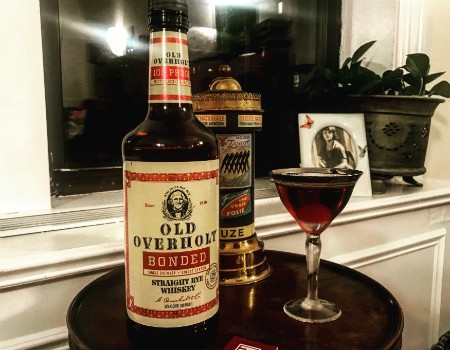Old Overholt Goes Old School With Its New Bonded Rye
Contributed by on Feb 04, 2018
Sixteen readers love this post.
When I first discovered rye whiskey in the mid '90s, the category was running on fumes. Once the brown spirit of choice throughout the lower 48, rye's popularity had been nosediving since Prohibition ended. My neighborhood liquor store stocked two ryes, which was about par for the course back then. One was Jim Beam, and the other was Old Overholt. I didn't know the particulars of either one. Old Overholt, with its odd name and rather fusty-looking label sporting a somber looking 19th century gent and emblazoned with the phrase "Since 1810," seemed like the real deal, the serious stuff. And it was cheap! A short walk home and a quick mixing session later, I was downing my first rye Manhattan. And I was sold. Compared to bourbon, it was dry, it was spicy, it made me feel like I'd graduated from the kid stuff. For years, when I proselytized to friends about the magic and mystery of rye to my friends — none of whom had tried it, either — I used Old Overholt to convert them.

I didn't know that Old Overholt had been made in Pennsylvania for more than a century before the brand was bought in the '80s (by Jim Beam, it turns out) and production moved to Kentucky. I didn't know that when it was moved, the mashbill had been changed and the proof watered down. I didn't know that serious devotees of rye whiskey, had I been able to find them, would have turned up their noses at what I was drinking. I just knew I liked Old Overholt a lot. And to this day, though my bottle of OO lingers longer at the back of my liquor cabinet, after having tasted countless artisanal, more "authentic" ryes, it still informs what I think rye whiskey ought to taste like.
Which is why I'm thrilled about the release of Old Overholt Bonded Rye. Bottled-in-bond is a product of the 1890s, when there was the very real risk that the bottle of whiskey you bought would, at the least, not be aged as long as was stated on the bottle, and at worst could be adulterated in some deleterious manner. Bottled-in-bond brought the government in to ensure that bonded whiskeys were distilled by a single distiller at a single distillery during a single distilling season; aged for no less than four years; and bottled at exactly 100 proof. Bottled-in-bond used to be a trademark of quality; today it's often regarded as a quaint anachronism. The thing is, though, that the bottled-in-bond generally results in excellent whiskey. And for the most part, they're cheaper than the super-annuated whiskeys that get a lot more attention.
The Bonded mashbill is the same as standard Old Overholt's, which was changed in the '80s to a high-corn, relatively low-rye mix — this isn't your grandpa's Old Overholt. But it's still damn good, with dominant notes of chocolate, cinnamon and dark fruit. Comparing it with the standard version, it's like seeing an old friend who's started going to the gym since you've last seen him — the same, but bigger and buffer. It reminds me of Knob Creek Rye, which is also made by Jim Beam and is also bottled at 100 proof. But Knob Creek runs a little hotter, with a bigger alcoholic kick on the finish, while Bonded Old Overholt is smoother and more viscous. It's not quite a sipper, although in a pinch a glass and an ice cube is all you really need to enjoy it. But as a mixer, namely in a Manhattan, it's terrific. And at $25, it's quite the bargain.
Old Overholt Bonded isn't a thoroughbred rye, one of those pricey, artfully crafted gems that you dust off and bring out for special occasions. It's a workhorse, an everyday rye, a prosaic whiskey. And hopefully along the way it'll open some eyes to the majesty of rye the way that 80 proof bottle of OO did for me all those years ago.
